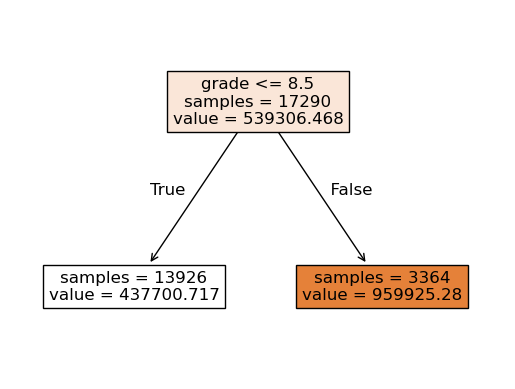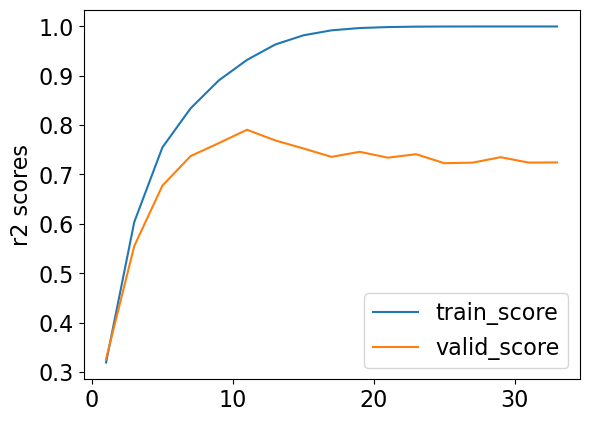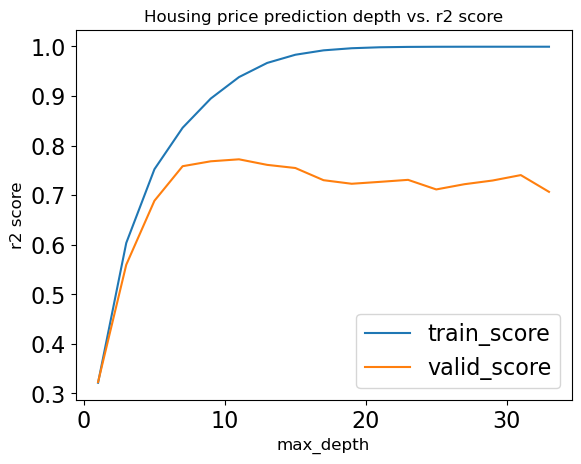Lecture 2: Class demo#
Imports#
# import the libraries
import os
import sys
sys.path.append(os.path.join(os.path.abspath(".."), (".."), "code"))
from plotting_functions import *
from utils import *
import matplotlib.pyplot as plt
import numpy as np
import pandas as pd
%matplotlib inline
pd.set_option("display.max_colwidth", 200)
Data and Exploratory Data Analysis (EDA)#
Let’s bring back King County housing sale prediction data from the course introduction video. You can download the data from here.
housing_df = pd.read_csv('../../data/kc_house_data.csv')
housing_df
| id | date | price | bedrooms | bathrooms | sqft_living | sqft_lot | floors | waterfront | view | ... | grade | sqft_above | sqft_basement | yr_built | yr_renovated | zipcode | lat | long | sqft_living15 | sqft_lot15 | |
|---|---|---|---|---|---|---|---|---|---|---|---|---|---|---|---|---|---|---|---|---|---|
| 0 | 7129300520 | 20141013T000000 | 221900.0 | 3 | 1.00 | 1180 | 5650 | 1.0 | 0 | 0 | ... | 7 | 1180 | 0 | 1955 | 0 | 98178 | 47.5112 | -122.257 | 1340 | 5650 |
| 1 | 6414100192 | 20141209T000000 | 538000.0 | 3 | 2.25 | 2570 | 7242 | 2.0 | 0 | 0 | ... | 7 | 2170 | 400 | 1951 | 1991 | 98125 | 47.7210 | -122.319 | 1690 | 7639 |
| 2 | 5631500400 | 20150225T000000 | 180000.0 | 2 | 1.00 | 770 | 10000 | 1.0 | 0 | 0 | ... | 6 | 770 | 0 | 1933 | 0 | 98028 | 47.7379 | -122.233 | 2720 | 8062 |
| 3 | 2487200875 | 20141209T000000 | 604000.0 | 4 | 3.00 | 1960 | 5000 | 1.0 | 0 | 0 | ... | 7 | 1050 | 910 | 1965 | 0 | 98136 | 47.5208 | -122.393 | 1360 | 5000 |
| 4 | 1954400510 | 20150218T000000 | 510000.0 | 3 | 2.00 | 1680 | 8080 | 1.0 | 0 | 0 | ... | 8 | 1680 | 0 | 1987 | 0 | 98074 | 47.6168 | -122.045 | 1800 | 7503 |
| ... | ... | ... | ... | ... | ... | ... | ... | ... | ... | ... | ... | ... | ... | ... | ... | ... | ... | ... | ... | ... | ... |
| 21608 | 263000018 | 20140521T000000 | 360000.0 | 3 | 2.50 | 1530 | 1131 | 3.0 | 0 | 0 | ... | 8 | 1530 | 0 | 2009 | 0 | 98103 | 47.6993 | -122.346 | 1530 | 1509 |
| 21609 | 6600060120 | 20150223T000000 | 400000.0 | 4 | 2.50 | 2310 | 5813 | 2.0 | 0 | 0 | ... | 8 | 2310 | 0 | 2014 | 0 | 98146 | 47.5107 | -122.362 | 1830 | 7200 |
| 21610 | 1523300141 | 20140623T000000 | 402101.0 | 2 | 0.75 | 1020 | 1350 | 2.0 | 0 | 0 | ... | 7 | 1020 | 0 | 2009 | 0 | 98144 | 47.5944 | -122.299 | 1020 | 2007 |
| 21611 | 291310100 | 20150116T000000 | 400000.0 | 3 | 2.50 | 1600 | 2388 | 2.0 | 0 | 0 | ... | 8 | 1600 | 0 | 2004 | 0 | 98027 | 47.5345 | -122.069 | 1410 | 1287 |
| 21612 | 1523300157 | 20141015T000000 | 325000.0 | 2 | 0.75 | 1020 | 1076 | 2.0 | 0 | 0 | ... | 7 | 1020 | 0 | 2008 | 0 | 98144 | 47.5941 | -122.299 | 1020 | 1357 |
21613 rows × 21 columns
Is this a classification problem or a regression problem?#
# How many data points do we have?
housing_df.shape
(21613, 21)
# What are the columns in the dataset?
housing_df.columns
Index(['id', 'date', 'price', 'bedrooms', 'bathrooms', 'sqft_living',
'sqft_lot', 'floors', 'waterfront', 'view', 'condition', 'grade',
'sqft_above', 'sqft_basement', 'yr_built', 'yr_renovated', 'zipcode',
'lat', 'long', 'sqft_living15', 'sqft_lot15'],
dtype='object')
Let’s explore the features. Let’s try the info() method.
housing_df.info()
<class 'pandas.core.frame.DataFrame'>
RangeIndex: 21613 entries, 0 to 21612
Data columns (total 21 columns):
# Column Non-Null Count Dtype
--- ------ -------------- -----
0 id 21613 non-null int64
1 date 21613 non-null object
2 price 21613 non-null float64
3 bedrooms 21613 non-null int64
4 bathrooms 21613 non-null float64
5 sqft_living 21613 non-null int64
6 sqft_lot 21613 non-null int64
7 floors 21613 non-null float64
8 waterfront 21613 non-null int64
9 view 21613 non-null int64
10 condition 21613 non-null int64
11 grade 21613 non-null int64
12 sqft_above 21613 non-null int64
13 sqft_basement 21613 non-null int64
14 yr_built 21613 non-null int64
15 yr_renovated 21613 non-null int64
16 zipcode 21613 non-null int64
17 lat 21613 non-null float64
18 long 21613 non-null float64
19 sqft_living15 21613 non-null int64
20 sqft_lot15 21613 non-null int64
dtypes: float64(5), int64(15), object(1)
memory usage: 3.5+ MB
Let’s try the describe() method
housing_df.describe()
| id | price | bedrooms | bathrooms | sqft_living | sqft_lot | floors | waterfront | view | condition | grade | sqft_above | sqft_basement | yr_built | yr_renovated | zipcode | lat | long | sqft_living15 | sqft_lot15 | |
|---|---|---|---|---|---|---|---|---|---|---|---|---|---|---|---|---|---|---|---|---|
| count | 2.161300e+04 | 2.161300e+04 | 21613.000000 | 21613.000000 | 21613.000000 | 2.161300e+04 | 21613.000000 | 21613.000000 | 21613.000000 | 21613.000000 | 21613.000000 | 21613.000000 | 21613.000000 | 21613.000000 | 21613.000000 | 21613.000000 | 21613.000000 | 21613.000000 | 21613.000000 | 21613.000000 |
| mean | 4.580302e+09 | 5.400881e+05 | 3.370842 | 2.114757 | 2079.899736 | 1.510697e+04 | 1.494309 | 0.007542 | 0.234303 | 3.409430 | 7.656873 | 1788.390691 | 291.509045 | 1971.005136 | 84.402258 | 98077.939805 | 47.560053 | -122.213896 | 1986.552492 | 12768.455652 |
| std | 2.876566e+09 | 3.671272e+05 | 0.930062 | 0.770163 | 918.440897 | 4.142051e+04 | 0.539989 | 0.086517 | 0.766318 | 0.650743 | 1.175459 | 828.090978 | 442.575043 | 29.373411 | 401.679240 | 53.505026 | 0.138564 | 0.140828 | 685.391304 | 27304.179631 |
| min | 1.000102e+06 | 7.500000e+04 | 0.000000 | 0.000000 | 290.000000 | 5.200000e+02 | 1.000000 | 0.000000 | 0.000000 | 1.000000 | 1.000000 | 290.000000 | 0.000000 | 1900.000000 | 0.000000 | 98001.000000 | 47.155900 | -122.519000 | 399.000000 | 651.000000 |
| 25% | 2.123049e+09 | 3.219500e+05 | 3.000000 | 1.750000 | 1427.000000 | 5.040000e+03 | 1.000000 | 0.000000 | 0.000000 | 3.000000 | 7.000000 | 1190.000000 | 0.000000 | 1951.000000 | 0.000000 | 98033.000000 | 47.471000 | -122.328000 | 1490.000000 | 5100.000000 |
| 50% | 3.904930e+09 | 4.500000e+05 | 3.000000 | 2.250000 | 1910.000000 | 7.618000e+03 | 1.500000 | 0.000000 | 0.000000 | 3.000000 | 7.000000 | 1560.000000 | 0.000000 | 1975.000000 | 0.000000 | 98065.000000 | 47.571800 | -122.230000 | 1840.000000 | 7620.000000 |
| 75% | 7.308900e+09 | 6.450000e+05 | 4.000000 | 2.500000 | 2550.000000 | 1.068800e+04 | 2.000000 | 0.000000 | 0.000000 | 4.000000 | 8.000000 | 2210.000000 | 560.000000 | 1997.000000 | 0.000000 | 98118.000000 | 47.678000 | -122.125000 | 2360.000000 | 10083.000000 |
| max | 9.900000e+09 | 7.700000e+06 | 33.000000 | 8.000000 | 13540.000000 | 1.651359e+06 | 3.500000 | 1.000000 | 4.000000 | 5.000000 | 13.000000 | 9410.000000 | 4820.000000 | 2015.000000 | 2015.000000 | 98199.000000 | 47.777600 | -121.315000 | 6210.000000 | 871200.000000 |
Should we include all columns?#
housing_df['id'] # Should we include the id column?
0 7129300520
1 6414100192
2 5631500400
3 2487200875
4 1954400510
...
21608 263000018
21609 6600060120
21610 1523300141
21611 291310100
21612 1523300157
Name: id, Length: 21613, dtype: int64
housing_df['date'] # What about the date column?
0 20141013T000000
1 20141209T000000
2 20150225T000000
3 20141209T000000
4 20150218T000000
...
21608 20140521T000000
21609 20150223T000000
21610 20140623T000000
21611 20150116T000000
21612 20141015T000000
Name: date, Length: 21613, dtype: object
housing_df['zipcode'] # What about the zipcode column?
0 98178
1 98125
2 98028
3 98136
4 98074
...
21608 98103
21609 98146
21610 98144
21611 98027
21612 98144
Name: zipcode, Length: 21613, dtype: int64
# What are the value counts of the `waterfront` feature?
housing_df['waterfront'].value_counts()
waterfront
0 21450
1 163
Name: count, dtype: int64
# What are the value_counts of `yr_renovated` feature?
housing_df['yr_renovated'].value_counts()
yr_renovated
0 20699
2014 91
2013 37
2003 36
2005 35
...
1951 1
1959 1
1948 1
1954 1
1944 1
Name: count, Length: 70, dtype: int64
Many opportunities to clean the data but we’ll stop here.
Let’s create X and y.
X = housing_df.drop(columns=['id', 'date', 'zipcode', 'price'])
y = housing_df['price']
Baseline model#
# Train a DummyRegressor model
from sklearn.dummy import DummyRegressor # Import DummyRegressor
# Create a class object for the sklearn model.
dummy = DummyRegressor()
# fit the dummy regressor
dummy.fit(X, y)
# score the model
dummy.score(X, y)
0.0
# predict on X using the model
dummy.predict(X)
array([540088.14176653, 540088.14176653, 540088.14176653, ...,
540088.14176653, 540088.14176653, 540088.14176653])
Decision tree model#
# Train a decision tree model
from sklearn.tree import DecisionTreeRegressor # Import DecisionTreeRegressor
# Create a class object for the sklearn model.
dt = DecisionTreeRegressor(random_state=123)
# fit the decision tree regressor
dt.fit(X, y)
# score the model
dt.score(X, y)
0.9991338290544213
We are getting a perfect accuracy. Should we be happy with this model and deploy it? Why or why not?
What’s the depth of this model?
dt.get_depth()
38
Data splitting#
Let’s split the data and
Train on the train split
Score on the test split
# Split the data
from sklearn.model_selection import train_test_split
X_train, X_test, y_train, y_test = train_test_split(X, y, test_size=0.2, random_state=123)
# Instantiate a class object
dt = DecisionTreeRegressor(random_state=123)
# Train a decision tree on X_train, y_train
dt.fit(X_train, y_train)
# Score on the train set
dt.score(X_train, y_train)
0.9994394006711425
# Score on the test set
dt.score(X_test, y_test)
0.719915905190645
Activity: Discuss the following questions in your group#
Why is there a large gap between train and test scores?
What would be the effect of increasing or decreasing
test_size?Why are we setting the
random_state? Is it a good idea to try a bunch of values for therandom_stateand pick the one which gives the best scores?Would it be possible to further improve the scores?
Let’s try out different depths.
# max_depth= 1
dt = DecisionTreeRegressor(max_depth=1, random_state=123)
dt.fit(X_train, y_train)
DecisionTreeRegressor(max_depth=1, random_state=123)In a Jupyter environment, please rerun this cell to show the HTML representation or trust the notebook.
On GitHub, the HTML representation is unable to render, please try loading this page with nbviewer.org.
DecisionTreeRegressor(max_depth=1, random_state=123)
# Visualize your decision stump
from sklearn.tree import plot_tree
plot_tree(dt, feature_names = X.columns.tolist(), impurity=False, filled=True, fontsize=12);

dt.score(X_train, y_train) # Score on the train set
0.3209427041566191
dt.score(X_test, y_test) # Score on the test set
0.31767136668453344
How do these scores compare to the previous scores?
Let’s try depth 10.
dt = DecisionTreeRegressor(max_depth=10, random_state=123) # max_depth= 10
dt.fit(X_train, y_train)
DecisionTreeRegressor(max_depth=10, random_state=123)In a Jupyter environment, please rerun this cell to show the HTML representation or trust the notebook.
On GitHub, the HTML representation is unable to render, please try loading this page with nbviewer.org.
DecisionTreeRegressor(max_depth=10, random_state=123)
dt.score(X_train, y_train) # Score on the train set
0.9108334653214172
dt.score(X_test, y_test) # Score on the test set
0.7728396574320712
Any improvements? Which depth should we pick?
Single validation set#
We are using the test data again and again. How about creating a validation set to pick the right depth and assessing the final model on the test set?
# Create a validation set
X_tr, X_valid, y_tr, y_valid = train_test_split(X_train, y_train, test_size=0.2, random_state=123)
tr_scores = []
valid_scores = []
depths = np.arange(1, 35, 2)
for depth in depths:
# Create and fit a decision tree model for the given depth
dt = DecisionTreeRegressor(max_depth=depth, random_state=123)
# Calculate and append r2 scores on the training and validation sets
dt.fit(X_tr, y_tr)
tr_scores.append(dt.score(X_tr, y_tr))
valid_scores.append(dt.score(X_valid, y_valid))
results_single_valid_df = pd.DataFrame({"train_score": tr_scores,
"valid_score": valid_scores},index = depths)
results_single_valid_df
| train_score | valid_score | |
|---|---|---|
| 1 | 0.319559 | 0.326616 |
| 3 | 0.603739 | 0.555180 |
| 5 | 0.754938 | 0.677567 |
| 7 | 0.833913 | 0.737285 |
| 9 | 0.890456 | 0.763480 |
| 11 | 0.931896 | 0.790521 |
| 13 | 0.963024 | 0.769030 |
| 15 | 0.981643 | 0.752728 |
| 17 | 0.991810 | 0.735637 |
| 19 | 0.996424 | 0.745925 |
| 21 | 0.998370 | 0.734048 |
| 23 | 0.999213 | 0.741060 |
| 25 | 0.999480 | 0.722873 |
| 27 | 0.999544 | 0.723951 |
| 29 | 0.999558 | 0.734986 |
| 31 | 0.999562 | 0.724068 |
| 33 | 0.999567 | 0.724410 |
results_single_valid_df[['train_score', 'valid_score']].plot(ylabel='r2 scores');

What depth gives the “best” validation score?
best_depth = results_single_valid_df['valid_score'].idxmax()
best_depth
np.int64(11)
Let’s assess the best model on the test set.
test_model = DecisionTreeRegressor(max_depth=best_depth, random_state=123)
test_model.fit(X_train, y_train)
test_model.score(X_test, y_test)
0.7784948928666875
How do the test scores compare to the validation scores?
Can we have a more robust estimate of the test score?
Cross-validation#
depths = np.arange(1, 35, 2)
cv_train_scores = []
cv_valid_scores = []
for depth in depths:
# Create and fit a decision tree model for the given depth
dt = DecisionTreeRegressor(max_depth = depth, random_state=123)
# Carry out cross-validation
scores = cross_validate(dt, X_train, y_train, return_train_score=True)
cv_train_scores.append(scores['train_score'].mean())
cv_valid_scores.append(scores['test_score'].mean())
results_df = pd.DataFrame({"train_score": cv_train_scores,
"valid_score": cv_valid_scores
},
index=depths
)
results_df
| train_score | valid_score | |
|---|---|---|
| 1 | 0.321050 | 0.322465 |
| 3 | 0.603243 | 0.559284 |
| 5 | 0.752169 | 0.688484 |
| 7 | 0.835876 | 0.758259 |
| 9 | 0.894960 | 0.768184 |
| 11 | 0.938201 | 0.772185 |
| 13 | 0.966812 | 0.760966 |
| 15 | 0.983340 | 0.754620 |
| 17 | 0.992220 | 0.730025 |
| 19 | 0.996487 | 0.722803 |
| 21 | 0.998440 | 0.726659 |
| 23 | 0.999178 | 0.730704 |
| 25 | 0.999438 | 0.711356 |
| 27 | 0.999518 | 0.721917 |
| 29 | 0.999539 | 0.729374 |
| 31 | 0.999545 | 0.740319 |
| 33 | 0.999546 | 0.706489 |
results_df[['train_score', 'valid_score']].plot();
plt.title('Housing price prediction depth vs. r2 score', fontsize=12) # Adjust title font size
plt.xlabel('max_depth', fontsize=12) # Adjust x-axis label font size
plt.ylabel('r2 score', fontsize=12); # Adjust y-axis label font size

What’s the “best” depth with cross-validation?
best_depth = results_df['valid_score'].idxmax()
best_depth
np.int64(11)
Discuss the following questions in your group#
For which depth(s) we are underfitting? How about overfitting?
Above we are picking the depth which gives us the best cross-validation score. Is it always a good idea to pick such a depth? What if you have a much simpler model (smaller
max_depth), which gives us almost the same CV scores?If we care about the test scores in the end, why don’t we use it in training?
Do you trust our hyperparameter optimization? In other words, do you believe that we have found the best possible depth?
Assessing on the test set#
dt_final = DecisionTreeRegressor(max_depth=best_depth, random_state=123)
dt_final.fit(X_train, y_train)
dt_final.score(X_train, y_train)
0.9308647034083802
dt_final.score(X_test, y_test)
0.7784948928666875
How do these scores compare to the scores when we used a single validation set?
Learned model#
#What's the depth of the model?
dt_final.get_depth()
11
# plot_tree(dt_final, feature_names = X_train.columns.tolist(), impurity=False, filled=True);
# Which features are the most important ones?
dt_final.feature_importances_
array([0.00080741, 0.00327551, 0.25123925, 0.01808825, 0.00079645,
0.03213916, 0.01190633, 0.00106308, 0.36400802, 0.02313684,
0.00295235, 0.01209545, 0.00064647, 0.17216105, 0.06835056,
0.02416048, 0.01317334])
Let’s examine feature importances.
df = pd.DataFrame(
data = {
"features": dt_final.feature_names_in_,
"feature_importances": dt_final.feature_importances_
}
)
df.sort_values("feature_importances", ascending=False)
| features | feature_importances | |
|---|---|---|
| 8 | grade | 0.364008 |
| 2 | sqft_living | 0.251239 |
| 13 | lat | 0.172161 |
| 14 | long | 0.068351 |
| 5 | waterfront | 0.032139 |
| 15 | sqft_living15 | 0.024160 |
| 9 | sqft_above | 0.023137 |
| 3 | sqft_lot | 0.018088 |
| 16 | sqft_lot15 | 0.013173 |
| 11 | yr_built | 0.012095 |
| 6 | view | 0.011906 |
| 1 | bathrooms | 0.003276 |
| 10 | sqft_basement | 0.002952 |
| 7 | condition | 0.001063 |
| 0 | bedrooms | 0.000807 |
| 4 | floors | 0.000796 |
| 12 | yr_renovated | 0.000646 |
Summary#
Concepts we revised in this demo#
Exploratory data analysis
Baselines
Data splitting: train, test, validation sets
Cross validation
Underfitting, overfitting, the fundamental tradeoff
The golden rule of supervised ML
Typical steps to build a supervised machine learning model#
Ensure the data is appropriate for your task (e.g., labeled data, suitable features).
Split the data into training and testing sets.
Perform exploratory data analysis (EDA) on the training data to understand distributions, identify patterns, and detect potential issues.
Preprocess and encode features (e.g., handle missing values, scale features, encode categorical variables)
coming up
Build a baseline model to establish a performance benchmark.
Train multiple candidate models on the training data
coming up
Select promising models and perform hyperparameter tuning using cross-validation.
coming up
Evaluate the generalization performance of the best model on the test set.
